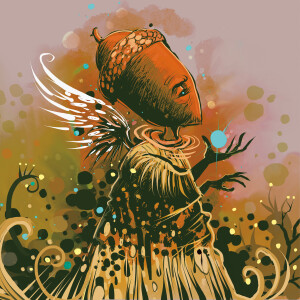 This is an absolutely spellbinding record that defies easy description, so settle in. Jay Hammond, now based in Durham, North Carolina by way of Brooklyn, and his musical collective called Trippers & Askers, have created a layered masterpiece of spiritual, jazzy indie folk music that speaks of hope to this pandemic-battered and climate change scorched world. Their message is inspired by the prescient words of an African American science fiction author from a half-century ago.
This is an absolutely spellbinding record that defies easy description, so settle in. Jay Hammond, now based in Durham, North Carolina by way of Brooklyn, and his musical collective called Trippers & Askers, have created a layered masterpiece of spiritual, jazzy indie folk music that speaks of hope to this pandemic-battered and climate change scorched world. Their message is inspired by the prescient words of an African American science fiction author from a half-century ago.
The writer is the great Octavia Butler, and Hammond was inspired by her Parable of the Sower to create this cryptic work called Acorn. Think of it as folk music inspired by spiritual jazz, which one reviewer has called spiritual Americana.
It’s a compact album of eight songs lasting just shy of 40 minutes total. The album’s publicity says the two “sides” roughly coincide with the two phases of Butler’s Parable: “Side A of Acorn deals with the childhood of humanity on earth, with the discovery of Earthseed ushering us to the stars. Side B deals with a “sweet, sad and terrifying” adulthood that is oriented toward the creation of the first Earthseed community, ‘Acorn.’ ”
I haven’t read Butler’s book, so I’ll let the press release fill you in in case you also haven’t read it:
Parable of the Sower was written in the 1990s and set in 2020s U.S., when society has collapsed for everyone but the super wealthy due to climate change, wealth inequality, religious fundamentalism, and corporate greed. The protagonist – a woman named Lauren Olamina – embodies a kind of radical hope that has nothing to do with denial. In fact, it’s a kind of hope that can only spring from the fact that she understands the severity of her and her community’s situation better than anyone else. It’s a hope that is anchored by a religion that she creates called Earthseed, a way of seeing the world that many contemporary black feminist activists and musicians such as adrienne maree brown, Toshi Reagon and so many others have taken up as a spiritual roadmap toward liberation from an increasingly unacceptable present.
My apologies for taking so long to get to the music, but this background is pretty important to understanding that music. The first half is a bit more oriented toward Americana-type songs with a spiritual bent. The opener “Pulsing Place” introduces the album with a languid, lovely indie folk sound of Hammond’s weathered yet hopeful voice over layers of fingerpicked acoustic guitars. That basic sound is augmented by drones that come and go made by pedal steel, organ, horns, synthesizers and other keyboards.
This is a superb band, most members playing more than one instrument. In addition to songwriting and singing, Jay Hammond is a solid guitarist, and he also contributes mandolin, bass and electronics. Adding vocals are Chessa Rich and Andrew Carlson, and Rich also plays keyboards and flute, Carlson bass. The secret weapon may be Mike Grigoni on pedal steel, but Joseph O’Connell on pump organ, Joseph Decosimo on fiddle and Andy Stack on the little synth called an organelle contribute significantly to the droning arrangements and Stack also adds color on saxophone. Lush, creative drumming and percussion are courtesy of Joe Westerlund and Ken Moshesh, formerly of Sun Ra.
One place where many of those elements contribute to the whole is the standout second track “Chance’s Wake.” Three part harmonies and a country folk feel that gives way to a flamenco-inspired chorus, and winds down to a soothing coda make this my favorite.
The early straight folk setting of “Seeing Is A Gas” rises to a triumphant chorus with a wildly gorgeous soundscape of flute, violin, synths and thudding kickdrum. The song ends without resolution and is followed by the Side A closer “Earthseed,” which builds from a stark guitar-vocal arrangement to a more complex structure over a base of droning acoustic and electronic instruments and percussion.
The second half of the program moves toward more overt spiritual jazz, following the trippy psychedelic folk of “Henry.” The aptly named shuffling instrumental “Interstate Walk” featuring John Fahey-inspired fingerpicking and deep thudding percussion separates two very jazzy tracks. “Keeping Watch” has a film soundtrack vibe from its stuttering 6/8 time signature, psych guitar and chant-like hushed vocals. The closer “Making Forests” has uber-spiritual lyrics over another of those trick 6/8 rhythm figures that’s interspersed with straight time sections. A churchy organ, gentle guitars and a pulsing heart throb bass line drive it forward as Hammond intones overtly spiritual lyrics like “Don’t look in places that you used to, turn up stones in forests of your own making …”
To be honest, although I’m usually very much into lyrics, I haven’t parsed many of these yet. I’m still luxuriating in the deeply affecting arrangements and Hammond’s somehow soothing voice. Word has it that he’s working on another project inspired by Butler’s sequel, Parable of the Talents. I’ll be waiting.
(Sleepy Cat, 2021)
